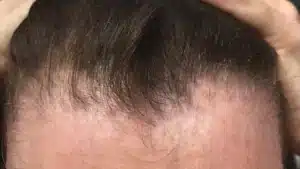Can you fix a receding hairline? Maybe. It depends on the diagnosis and when you start treatment.
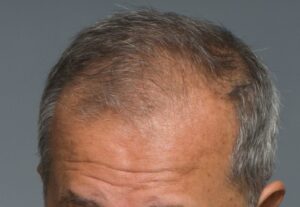
What causes a receding hairline?
Before we can ask, “can you fix a receding hairline?” we first have to define what it is. A receding hairline means that the person is experiencing hair loss, or alopecia, starting at the hair line. Alopecia can have many causes. Although we think of a receding hairline as a common presentation of male pattern hair loss, or androgenetic alopecia in men, there are a number of types of hair loss that present this way. Also, women can experience a receding hair line. How one fixes a receding hairline depends on the cause. Here are some examples:
Androgenetic Alopecia
Androgenetic alopecia, also known as male or female pattern baldness, is the most common cause of receding hairline. It is a genetic condition that is characterized by the gradual thinning of hair on the scalp. Androgenetic alopecia is caused by a combination of genetics, hormones, and age. It can have multiple patterns. Commonly in men, androgenetic alopecia affects the hairline. The hair line may have bitemporal hair loss sparing the midline or the entire frontal hairline may recede. In women with androgenetic alopecia, the hairline is typically spared.
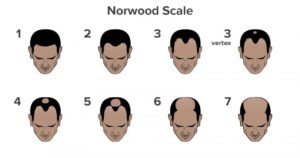
While there is no cure for androgenetic alopecia, several treatments can help slow down or even stop hair loss. Minoxidil is one such treatment, and it can be effective for both men and women. Finasteride is another medication that is used to treat androgenetic alopecia in men. It works by blocking the conversion of testosterone into dihydrotestosterone, which is a hormone that contributes to hair loss. Also popular are red light therapy, PRP, or transepidermal drug delivery devices such as the Alma TED.
- Minoxidil: This is a topical medication that is applied to the scalp to promote hair growth. It is available over the counter and is the only FDA-approved medication for hair loss treatment.
- Finasteride: This is an oral medication that is used to treat hair loss in men. It works by blocking the conversion of testosterone to dihydrotestosterone (DHT), which is a hormone that contributes to hair loss.
- Low-level laser therapy: This involves the use of light therapy to stimulate hair growth. It can be administered through a laser comb, helmet, or other devices.
- Platelet-rich plasma (PRP) therapy: This involves the injection of platelet-rich plasma, which is derived from the patient’s own blood, into the scalp. The growth factors in the plasma are thought to stimulate hair growth.
- Hair transplant surgery: This involves the transplantation of hair follicles from a donor area to the balding or thinning area of the scalp. It is a surgical procedure that can be done under local anesthesia.
- Alma TED: like PRP, Alma TED, which is transepidermal drug delivery, delivers growth factors but using ultrasound and a standardized serum instead of blood and needles. It is FDA-approved for androgenetic alopecia.
Traction Alopecia
Traction alopecia is a type of hair loss that occurs when the hair is pulled too tightly, causing damage to the hair follicles. It is often caused by tight hairstyles such as buns, braids, weaves, and ponytails. Traction alopecia can cause receding hairline, particularly along the hairline and temples. In most cases, traction alopecia isn’t permanent. If scarring has occurred, however, the hair might not grow back. If the scarring hasn’t involved the hair bulge it is possible to achieve regrowth.
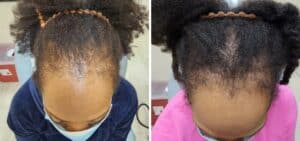
1 month after 1 treatment for traction alopecia
The best way to treat traction alopecia is to avoid tight or heavy hair styles. Sometimes just this change in grooming can achieve hair growth. If scarring has occurred, treatment is needed for the hair to regrow. Topical and injected steroids reduce the inflammation caused by the traction. This can allow follicles to function. Minoxidil is also helpful. Procedures such as PRP, Alma TED, and hair transplant are other techniques used to treat traction alopecia.
- Avoiding further hair tension: The first step in treating Traction Alopecia is to stop further hair pulling and tension. This may involve avoiding tight hairstyles, such as braids, weaves, and tight ponytails.
- Minoxidil: Can be applied to the affected areas to help stimulate hair growth.
- Steroid injections or topicals: Steroids can help reduce inflammation and promote hair growth.
- Platelet-rich plasma (PRP) therapy: PRP therapy involves the injection of platelet-rich plasma, which is derived from the patient’s own blood, into the scalp. The growth factors in the plasma are thought to stimulate hair growth and promote healing.
- Hair transplant surgery: In some cases, hair transplant surgery may be necessary to restore hair growth in areas that have been severely damaged by Traction Alopecia.
- Alma TED: FDA-approved transepidermal drug delivery device. It delivers growth factors using ultrasound and a standardized serum.
Ophiasis
Ophiasis is a type of alopecia areata that causes hair loss in a band-like or horseshoe pattern along the hairline. The affected area tends to be perfectly smooth. Ophiasis is rarer and can also be more stubborn to respond versus other types of alopecia areata. Luckily, there are a number of treatments for ophiasis.
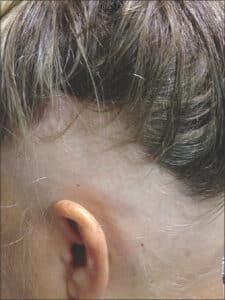
As this type of alopecia areata is an autoimmune disorder, corticosteroids can help. Corticosteroids, either applied topically or injected into the scalp, can help reduce inflammation and promote hair growth. Minoxidil may also be used to promote hair growth in the affected areas. Light therapy, methotrexate and now JAK inhibitors are also treatments for this type of receding hairline.
- Topical corticosteroids: These medications are applied directly to the affected area to reduce inflammation and suppress the immune system’s attack on hair follicles. They are often the first line of treatment for ophiasis and can be effective in promoting hair regrowth.
- Intralesional corticosteroid injections: If topical corticosteroids are not effective, a dermatologist may recommend injecting a corticosteroid solution directly into the affected area. This can help reduce inflammation and promote hair regrowth.
- Immunomodulatory drugs: These medications work by suppressing the immune system and reducing inflammation. They are typically prescribed for severe cases of ophiasis that do not respond to other treatments. These might include oral corticosteroids or JAK inhibitors.
- Topical immunotherapy: This treatment involves applying a chemical to the affected area that stimulates an allergic reaction. The allergic reaction triggers the immune system to attack the hair follicles, which can result in hair regrowth. This treatment is only recommended for select cases of ophiasis, as it can cause irritation and discoloration.
- Minoxidil: In conjunction with a treatment for the inflammation, minoxidil may be useful to stimulate regrowth in a receding hair line caused by ophiasis.
- Red light: An off-label use for red light is the treatment of types of hair loss other than androgenetic alopecia. It has hair stimulatory in addition to anti-inflammatory effects that may help reverse ophiasis.
- Hair transplantation: In cases where hair loss is permanent, hair transplantation may be an option. This involves transplanting healthy hair follicles from other areas of the scalp to the affected area.
Be sure to ask your dermatologist if they can fix a receding hairline, as the are the most qualified to work with during hair loss treatment.
Frontal Fibrosing Alopecia (FFA)
Frontal fibrosing alopecia is a type of scarring alopecia that causes hair loss along the front hairline and eyebrows. It is most commonly seen in postmenopausal women, but it can affect men and women of all ages. The exact cause of frontal fibrosing alopecia is unknown, but it is thought to be related to hormonal changes and perhaps sensitization to personal hygiene products. Sometimes flesh-colored papules occur on the forehead in people with this type of hair loss.
Unfortunately, for those asking, “can you fix a receding hairline?” when diagnosed with frontal fibrosing alopecia, the answer is NO. There is no cure with FFA. The goal is to manage it and prevent permanent scarring. There are several treatments that can help slow down the progression of hair loss.
- Corticosteroids: This is the most common treatment for FFA. A topical corticosteroid is applied directly to the affected area to help reduce inflammation and slow down hair loss. Sometimes the steroids are injected. It can be used in combination with other treatments such as minoxidil or oral medications.
- Minoxidil: This medication is typically used to treat male and female pattern baldness, but it has also been shown to be effective in treating FFA. It is a topical medication that is applied to the affected area to help stimulate hair growth.
- Oral Medications: Medications such as hydroxychloroquine and finasteride have been used to treat FFA. Hydroxychloroquine is an anti-inflammatory medication that can help reduce the inflammation associated with FFA, while finasteride can help reduce the production of DHT, a hormone that can contribute to hair loss.
- Platelet-Rich Plasma (PRP) Therapy: PRP therapy involves injecting a concentrated solution of platelets, growth factors, and other proteins into the scalp to help stimulate hair growth. This treatment has shown promising results in treating FFA, but more research is needed to determine its effectiveness.
- Hair Transplantation: In cases where FFA has resulted in permanent hair loss, hair transplantation may be an option. This involves transplanting healthy hair follicles from other areas of the scalp to the affected area. A hair transplant is only an option when the condition is not active.
Minoxidil for Receding Hairline
Minoxidil is a medication that is widely used to treat hair loss. Topical minoxidil, or Rogaine, is FDA-approved for androgenetic alopecia in men and women but the drug is used for most types of hair loss including those which cause a receding hairline. The topical drug is available over the counter and is applied directly to the scalp. Oral minoxidil, a blood pressure medicine, is also popular for hair loss. Minoxidil is known to increase blood flow to the hair follicles, which stimulates hair growth. It is also thought to extend the growth phase of hair follicles, resulting in thicker and fuller hair.
To use minoxidil, apply it directly to the scalp twice a day. It may take several months to see results, and the medication must be used regularly to maintain hair growth. While topical minoxidil is generally safe, it can cause side effects such as scalp irritation and unwanted hair growth on other parts of the body. With oral minoxidil, one must consider some of its side effects such as hypotension, pericardial effusion, and edema of the face and legs.
In conclusion- can you fix a receding hair line?
While it may seem like an irreversible problem, once one diagnoses the problem, there are several treatments available that can help fix a receding hairline– depending on the cause. It is important to note that the effectiveness of these treatments varies from person to person, and not all treatments may be suitable for every individual. It is best to consult with a dermatologist who specializes in hair loss to determine the most appropriate treatment plan; therefore, ask your dermatologist, “can you fix a receding hairline?”
Looking for hair loss dermatologist nyc? Schedule an appointment with our hair expert here!


